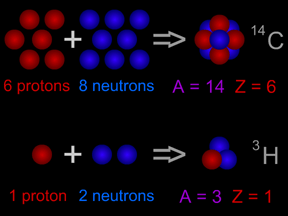Binding energy per nucleon as function of the nuclear mass
Image courtesy of Contemporary Physics Education Project (CPEP)
Binding Energy
A plot of the binding energy per nucleon vs. atomic mass shows a peak atomic
number 56 (Iron). Elements with atomic mass less then 56 release energy if formed
as a result of a fusion reaction. Above this threshold in order to release energy a
fission reaction must occur.
You might also be interested in:

One way scientists measure the size of something is by its mass. Mass is sort of like weight. Scientists can even measure very, very tiny things like atoms. One measure of the size of an atom is its "atomic
...more
A plot of the binding energy per nucleon vs. atomic mass shows a peak atomic number 56 (Iron). Elements with atomic mass less then 56 release energy if formed as a result of a fusion reaction. Above this
...more
Nuclear fusion has been achieved in a controlled manner (that means no bombs are involved!!). Right now, these fusion experiments take in more energy than they produce. So they can't be used right now
...more
In the Hydrogen bomb, an explosion takes place so that the temperature and density is right for fusion to occur. This fusion results in a sudden release of energy that produces an even bigger explosion.
...more
When the temperature in the core of a star is really hot (100 million degrees Kelvin!) fusion of Helium into Carbon happens. Oxygen is also formed when the temperature is this high. When it gets even hotter
...more
All of the matter and energy in the Universe was initially found in a very small space. An explosion happened which caused the Universe to begin expanding.
...more
The neutrino is an extremely light particle. (You definitely couldn't weigh one on your bathroom scale!) It also has no electric charge. Fusion reactions in the Sun produce neutrinos. By detecting these
...more














